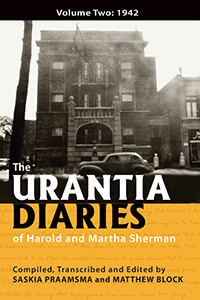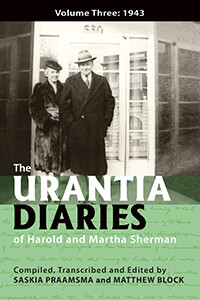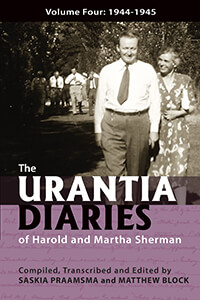
THE URANTIA DIARIES
of Harold and Martha Sherman
Introduction to Volume One
The years from approximately 1924 to 1955, in which the evolving manuscript of the Urantia Book was shared with a small group in Chicago called the Forum, is an intriguing period in the history of the Urantia Book and its readership. Only one source of extensive and detailed information about this period has come to light: the diaries and letters of Forumites Harold and Martha Sherman. During their stay in Chicago, from 1942 to 1947, the Shermans recorded what was said and done at every Forum meeting they attended. They also recorded their conversations with their Forumite friends and acquaintances outside Forum meetings. Their diligent documenting resulted in close to two thousand pages of eyewitness accounts which portray Forum life with unmatched vividness and immediacy
What makes their story especially piquant is that Harold was a controversial figure. Outspokenly critical of some of the plans of Forum leaders Dr. William S. Sadler and his son Bill, Harold was accused by Dr. Sadler of disrupting the superhumanly authorized running of the Forum. Sadler allowed the Shermans to continue to attend Forum meetings, but they became estranged from the Sadlers and kept aloof from most of the Forumites. Feeling unjustly blamed, the Shermans wrote sharp, critical reports of the ensuing Forum activities, which contrast with the vague, rosy accounts of the Forum given decades later by non-Forumites.
The first volume of The Urantia Diaries contains the correspondence Sherman had with Loose, Sadler, Sir Hubert Wilkins and others about the Urantia phenomenon before the Shermans arrived in Chicago in May 1942 and began attending the Forum and keeping the diaries. These letters are just as interesting historically as the diaries, giving a glimpse of how the knowledge of the Urantia text was diffused in these years.
Introduction to Volume Two
Covering May to December 1942, this volume records Harold and Martha Sherman’s first flush of enthusiasm for the Urantia revelation as well as the events that culminated in the first major conflict among Urantia believers. It provides a far more accurate account of this period than the truncated and pseudonymized version Harold gave in the “Pipeline to God” chapter of his 1976 book, How to Know What to Believe.
The volume opens as the Shermans arrive in Chicago and find an apartment directly across the street from the Sadler residence at 533 Diversey Parkway. They renew their acquaintance with Dr. Sadler and his relatives, meet other Forumites, and begin reading the Urantia papers and attending the Sunday Forum meetings. Soon joined by Sir Hubert Wilkins, the renowned polar explorer whom Sadler had admitted to the Forum on Harold’s recommendation, the new Forumites—Harold, Martha and Sir Hubert—are warmly welcomed by the people at 533.
Perhaps due to Sir Hubert’s celebrity and Harold’s recent success in Hollywood, combined with the men’s ardent interest in the Urantia phenomenon, the Shermans and Sir Hubert soon became favored Forumites. They sat at the Sadlers’ table at Forum events, and Sadler and his son Bill took them into special confidence, reading out to them accounts of interactions they had had with superhumans which weren’t included in the Urantia papers. Sadler also gave the Shermans a detailed account of the early years of the Urantia phenomenon, which apparently few Forumites had heard.
At the very time that the Shermans and Sir Hubert (who was only able to come to Chicago for short visits) were engaged in their first reading of the Urantia papers, Sadler announced, at the annual Forum picnic, that the Forum’s long-running role as a question-asking group was ending. Since about 1924, Forum members were invited to submit written questions which might influence the content of the developing Urantia manuscript. That role having been fulfilled as of May 31, 1942, the Forum was to continue studying the papers and to contribute funds for the eventual publication of the Urantia Book. The Sadlers had already formulated organizations—the Urantia Foundation and the Urantia Brotherhood—which would begin to function upon the publication of the book. The Foundation was to have absolute control over the production and translation of the Urantia Book, while the Brotherhood was to be the official membership organization of believers in the Urantia revelation.
But questions were just beginning for Harold and Martha as they read the manuscript and learned of the Sadlers’ publication and organization plans. Indeed, as this volume describes, Harold was besieged with questions and concerns. Throughout the late spring and summer of 1942 he shared his concerns and suggestions with the people at 533 and with the Forumites he and Martha had befriended. Not satisfied with the Sadlers’ responses, and encouraged when he learned that other Forumites shared his concerns to one degree or another, Harold helped write a petition, signed by almost fifty Forumites, asking Dr. Sadler to allow free and open discussion of the planned organizations.
Upon receiving the petition, Sadler, who had gotten wind of it beforehand thanks to two anxious Forumites, orchestrated a reaction which, in the course of a few days, succeeded in quashing virtually all sympathy for Harold and his proposals.
In the space of less than a month, the Shermans went from being favored Forum members to being largely shunned. They continued attending meetings for four-and-half more years as quiet observers. Harold shared his plight with a sympathetic Sir Hubert Wilkins, and the Shermans became close to a few Forumites who resisted Sadler’s apparent attempt to ostracize Harold. These few shared their confoundment at Sadler’s actions, which had revealed, to them, an unexpected, dark side to his character.
Throughout all these developments, the Shermans were in frequent correspondence with their mentor, Harry J. Loose, the eccentric retired policeman who had been a member of the Forum until 1934, when he and his wife Emily moved from Chicago to Monterey Park, California.
In addition to other advices, Loose encouraged the Shermans to keep a secret diary to use in a book Harold was to write about the history of the Urantia phenomenon. The Shermans began this diary on July 24, 1942 and maintained it for several years, even after leaving Chicago in 1947. They had also created a “Forum Calendar,” in which they jotted down notes of events which occurred from July 26, 1941 (when Harold was introduced by phone to Sadler) to November 18, 1942. Every entry of the diaries and of the Forum Calendar is included in these volumes.
Introduction to Volume Three
This volume documents a full year of Urantia-related activity as witnessed by Harold and Martha Sherman and described in their diaries and letters. During this year, 1943, the Shermans continue to attend the weekly Forum meetings almost without fail and to record their recollections soon afterward.
Feeling unjustly blamed by Dr. Sadler for the so-called rebellion the previous summer, they share their frustrations with their few friends in the Forum, and confide their growing doubts about the Doctor’s trustworthiness as custodian of the Urantia papers. Their closest confidante remains Harry J. Loose, now in failing health but still providing advice and instruction through long, frequent letters. The year culminates with Loose’s death, which Harold and Martha perceive as opening a new era in their lives. 1943 is also a busy year for Harold career-wise, as he continues his pursuits as author and playwright, and becomes host of his own radio program in Chicago.
Introduction to Volume Four
In this volume Harold and Martha Sherman report their Urantia-related experiences for the years 1944 and 1945. During this period the Forum hears the papers that became Part III of the Urantia Book, and the Shermans record their impressions of each paper as well as their discussions with Forum friends on these and other subjects. Harold is forced to miss a number of Forum meetings while in New York and Hollywood pursuing various book, stage and radio projects, but Martha attends regularly. No longer in the forefront of controversy, the Shermans quietly maintain their criticisms of Dr. Sadler’s handling of the papers. In late 1945 a frank meeting with Harry Loose’s close friend, Reverend Williams, causes the Shermans to reflect anew on their involvement with the Urantia project, resulting in a turning point of sorts.
Introduction to Volume Five
This volume documents the years 1946 to 1955, spanning Harold and Martha Sherman’s last year and a half as Forumites and the period leading up to the long-awaited publication of the Urantia Book.
In the summer of 1947, their younger daughter having graduated high school, the Shermans decided to move to their cottage in the Arkansas Ozarks. Finding little inspiration in the Jesus papers and frustrated by the stalemate in their relationship with the Forum leaders, the Shermans made their last appearance at 533 Diversey Parkway in December of 1947.
With Arkansas as his home base, Harold continued a busy career as a writer and traveling lecturer. After gaining entree into the New Thought movement as a speaker and teacher in the early 1950s, he became nationally known, but he continually sought to reach the wider public through film, television and radio. During his respites in Arkansas, he was active in community development projects, campaigning for paved roads, electrification and tourist attractions. But, as the Cold War developed and the threat of atomic war loomed, and as UFO sightings were gaining international attention, Harold was most concerned with trying to help people realize their “higher powers of mind” so as to forestall disaster and steer the world in a better direction.
During these years the Shermans kept in regular contact with a few Forumites, including Elsie Baumgartner, Rachel Gusler, and Sir Hubert Wilkins. Their letters—touching on matters personal, political, philosophical, and spiritual—provide a glimpse into the concerns and perspectives of members of the first generation of serious students of the Urantia papers. In their travels Harold and/or Martha met or renewed their acquaintance with a number of other Forumites and former Forumites, recording their experiences in letters and diary entries.
Further, Harold was instrumental in sparking San Diego businessman Webster Stafford’s enthusiasm for the Urantia papers and other purported revelations. Stafford’s documents, reproduced in this volume and on www.squarecircles.com, represent the first known attempt to appreciate the Urantia papers in the broader context of comparative analysis.





